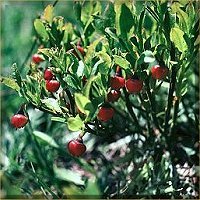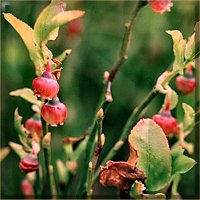


Vaccinium myrtillus L.



Vaccinium myrtillus L.
Other Names is a relative of Blueberry (Vaccinium spp.), Cowberry, Huckleberry (Vaccinium ovatum), Black whortleberry, Burren myrle, Dyeberry, Hurleberry, Whinberry, Whortleberry, Wineberry, Blaeberry, Whinberry, Myrtle blueberry
Origin - Europe (wild)
Part of the Plant used - Fresh fruit
Edible Parts - A shrubby perennial plant that grows in the sandy areas of the northern US and in the woods and forest meadows of Europe. The angular, green, branched stem grows from a creeping rootstock to a height of 1 to 1.5 feet. The leaves are alternate, obovate to ovate, weakly serrate, dark green and shiny on top and 0.5 to 1 inch long. The reddish pink or red and white, solitary, auxiliary flowers have a pitcher shaped corolla and appear in May and June. The fruit is usually blue-black; it may be red in some cases. The berry is 5-seeded.
Pharmacology - Bilberry is rich in anthocyanosides. Over 15 different anthocyanosides have been found in bilberry. Anthocyanosides are also potent antioxidants. Numerous clinical studies have shown that bilberry is effective in the treatment of circulation disorders, varicose veins, and other venous and arterial disorders. The anthocyanosides protect veins and arteries by stabilizing the phospholipids of the endothelial cells, and by increasing the synthesis of collagen and mucopolysaccharides which give the arterial walls their structural integrity. Anthocyanosides also prevent the aggregation and adherence of platelets to endothelial surfaces. Studies have also shown that bilberry can act as a coadjutant in hemeralopy and diabetic retinopathy and can stimulate rhodopsin production.
Medical use - Extracts of bilberry have antiviral properties in cell culture for herpes simplex virus II, influenza, and vaccinia viruses. Kills or inhibits the growth of funguses, yeasts, and bacteria. It also kills protozoans such as Trichomonas vaginalis. Bilberry is an anti-inflammatory herb. Anthocyanins in the herb act to prevent capillary fragility and inhibit platelet aggregation. Also has potential for the prevention of thrombosis and may reverse attacks of angina from results of animal studies. Was found to prevent atherosclerosis in cholesterol loaded animals. Further, bilberry is an antihistamine; it improves vision and has potential for the treatment of pigmentary retinitis. Modern research into bilberrys ability to increase visual accuity was partly based on its use by British World War II pilots, who noticed that their night vision improved when they ate bilberry jam prior to night bombing raids.
Dosage - People often take 240-480 mg per day of bilberry herbal extract in capsules or tablets standardized to provide 25 % anthocyanosides.Toxitity, Cautions & Cotraindications - In recommended amounts, there are no known side effects with bilberry extract. Bilberry does not interact with commonly prescribed drugs, and there are no known Contraindications to its use during pregnancy or lactation. Leaves can produce symptoms of poisoning if used over long periods.